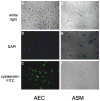Heterogeneity of transcription factor expression and regulation in human airway epithelial and smooth muscle cells
- PMID: 17557803
- PMCID: PMC6092943
- DOI: 10.1152/ajplung.00084.2007
Heterogeneity of transcription factor expression and regulation in human airway epithelial and smooth muscle cells
Abstract
Transcription factors represent a major mechanism by which cells establish basal and conditional expression of proteins, the latter potentially being adaptive or maladaptive in disease. The complement of transcription factors in two major structural cells of the lung relevant to asthma, airway epithelial and smooth muscle cells, is not known. A plate-based platform using nuclear extracts from these cells was used to assess potential expression by binding to oligonucleotide consensus sequences representing >300 transcription factors. Four conditions were studied: basal, beta-agonist exposure, culture under proasthmatic conditions (IL-13, IL-4, TGF-beta, and leukotriene D(4)), and the dual setting of beta-agonist with proasthmatic culture. Airway epithelial cells expressed 70 transcription factors, whereas airway smooth muscle expressed 110. High levels of multiple transcription factors not previously recognized as being expressed in these cells were identified. Moreover, expression/ binding patterns under these conditions revealed extreme discordance in the direction and magnitude of change between the cell types. Singular (one cell type displayed regulation) and antithetic (both cell types underwent expression changes but in opposite directions) regulation dominated these patterns, with concomitant regulation in both cell types being rare (<10%). beta-Agonist evoked up- and downregulation of transcription factors, which was highly influenced by the proasthmatic condition, with little overlap of factors regulated by beta-agonists under both conditions. Together, these results reveal complex, cell type-dependent networks of transcription factors in human airway epithelium and smooth muscle that are dynamically regulated in unique ways by beta-agonists and inflammation. These factors may represent additional components in asthma pathophysiology or potential new drug targets.
Figures





Similar articles
-
Transcriptional program of bone morphogenetic protein-2-induced epithelial and smooth muscle differentiation of pluripotent human embryonal carcinoma cells.Funct Integr Genomics. 2005 Apr;5(2):59-69. doi: 10.1007/s10142-005-0132-7. Epub 2005 Feb 3. Funct Integr Genomics. 2005. PMID: 15690164
-
Airway epithelium stimulates smooth muscle proliferation.Am J Respir Cell Mol Biol. 2009 Sep;41(3):297-304. doi: 10.1165/rcmb.2008-0358OC. Epub 2009 Jan 16. Am J Respir Cell Mol Biol. 2009. PMID: 19151317 Free PMC article.
-
The activation of M3 mAChR in airway epithelial cells promotes IL-8 and TGF-β1 secretion and airway smooth muscle cell migration.Respir Res. 2016 Mar 8;17:25. doi: 10.1186/s12931-016-0344-5. Respir Res. 2016. PMID: 26956674 Free PMC article.
-
Bronchial epithelium as a target for innovative treatments in asthma.Pharmacol Ther. 2013 Dec;140(3):290-305. doi: 10.1016/j.pharmthera.2013.07.008. Epub 2013 Jul 21. Pharmacol Ther. 2013. PMID: 23880290 Review.
-
Immune induction of airway remodeling.Semin Immunol. 2019 Dec;46:101346. doi: 10.1016/j.smim.2019.101346. Epub 2019 Nov 14. Semin Immunol. 2019. PMID: 31734128 Review.
Cited by
-
Regulatory haplotypes in ARG1 are associated with altered bronchodilator response.Am J Respir Crit Care Med. 2011 Feb 15;183(4):449-54. doi: 10.1164/rccm.201005-0758OC. Epub 2010 Sep 17. Am J Respir Crit Care Med. 2011. PMID: 20851928 Free PMC article. Clinical Trial.
-
A polymorphism in the thyroid hormone receptor gene is associated with bronchodilator response in asthmatics.Pharmacogenomics J. 2013 Apr;13(2):130-6. doi: 10.1038/tpj.2011.56. Epub 2012 Jan 3. Pharmacogenomics J. 2013. PMID: 22212731 Free PMC article.
-
Agonist-promoted homologous desensitization of human airway smooth muscle bitter taste receptors.Am J Respir Cell Mol Biol. 2011 Nov;45(5):1069-74. doi: 10.1165/rcmb.2011-0061OC. Epub 2011 Jun 3. Am J Respir Cell Mol Biol. 2011. PMID: 21642585 Free PMC article.
-
Bitter taste receptors on airway smooth muscle bronchodilate by localized calcium signaling and reverse obstruction.Nat Med. 2010 Nov;16(11):1299-304. doi: 10.1038/nm.2237. Epub 2010 Oct 24. Nat Med. 2010. PMID: 20972434 Free PMC article.
-
Pleiotropic Effects of Bitter Taste Receptors on [Ca2+]i Mobilization, Hyperpolarization, and Relaxation of Human Airway Smooth Muscle Cells.PLoS One. 2015 Jun 29;10(6):e0131582. doi: 10.1371/journal.pone.0131582. eCollection 2015. PLoS One. 2015. PMID: 26121686 Free PMC article.
References
-
- Auphan N, DiDonato JA, Rosette C, Helmberg A, Karin M. Immunosuppression by glucocorticoids: inhibition of NF-kappa B activity through induction of I kappa B synthesis. Science. 1995;270:286–290. - PubMed
-
- Barnes PJ. Transcription factors in airway diseases. Laboratory Investigation. 2006;86:867–872. - PubMed
-
- Barnes PJ, Adcock IM. Transcription factors and asthma. Eur Respir J. 1998;12:221–234. - PubMed
-
- Beasley R, Pearce N, Crane J, Burgess C. Beta-agonists: what is the evidence that their use increases the risk of asthma morbidity and mortality? J Allergy Clin Immunol. 1999;103:S18–S30. - PubMed
-
- Deshpande DA, Penn RB. Targeting G protein-coupled receptor signaling in asthma. Cell Signal. 2006;18:2105–2120. - PubMed
Publication types
MeSH terms
Substances
Grants and funding
LinkOut - more resources
Full Text Sources
Medical

